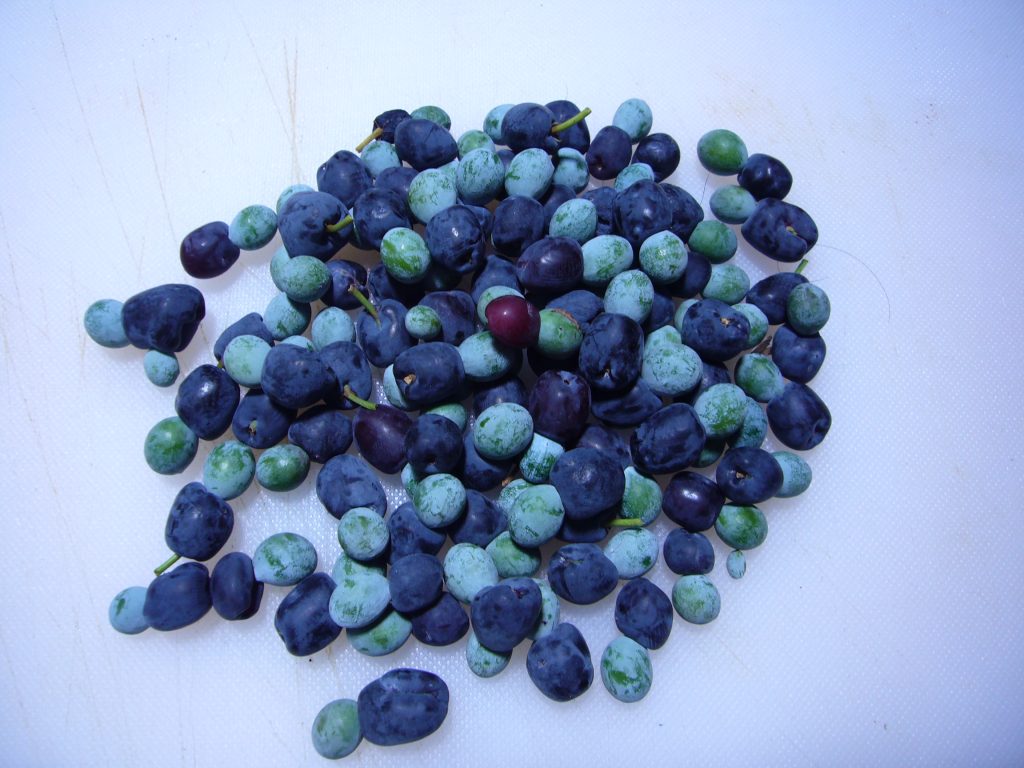
Podocarpous arils and seeds. Photo by Green Deane
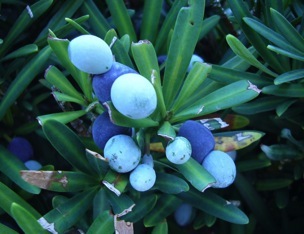
Podocarpus seeds — on the end — are not edible. photo by Green Deane
Podocarpus usually ripen in mid-August. Though newly transplanted shrubs can fruit within a few weeks any time of year. And we have also seen some adult trees fruiting between Thanksgiving and Christmas.
There are two controversies involving the podocarpus. One is that it is sometimes called the southern Yew, which is a different species that is quite toxic, Torreya floridana. The point is if someone is calling your shrub a Southern Yew you need to know if it is really a yew or a podocarpus. Yew seeds can kill you.
We also don’t eat the podocarpus seed, which is on the end next to the aril. A stem runs through aril to the seed. Decades ago that stem was viewed as harmless. Though some writers in recent times have said the stem is not good for kids to eat. I’ve seen kids eat them without issue.
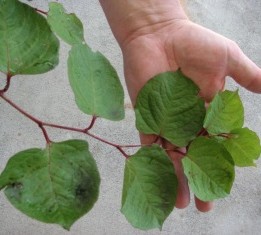
Japanese Knotweed. Photo by Green Deane
I am not sure it was with interest or amusement when I read about the Olympic Knotweed Working Group in Port Hadlock, Washington state. They have a knotweed problem that requires organization to combat it. That reminded me of the the Olympic stadium virtually half way around the world in London. It was a site of knotweed infestation and under British law the soil had to be removed and dealt with severely. That added 70 million pounds to the cost of building that stadium. That’s way in excess of $100 million dollars. Knotweed can break up concrete so it really had to be removed completely where the stadium was built. In Washington state there’s was an on-going study of how various herbicides and their application can kill of this edible weed. It’s fairly common in cooler climates and I’ve see a lot of it in the Carolinas. If I remember correctly it is also a commercial source of the anti-oxidant resveratrol. If you want to know more about knotweed click here.
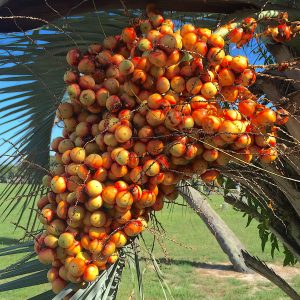
Pindo Palm can fruit almost anytime. Photo by Green Deane
July is passing and that means many different things to foragers depending upon your location on the rotation. In a particular latitudinal belt around the world it means the Pindo Palms are in fruit — my favorite after coconut which also fruit in south Florida. And don’t think Pindo Palms are just a warm region plant. They grow as far north as Washington DC and elsewhere in under protection. Also call the Jelly Palm, they were standard landscaping for every southern home because you can make a jelly from the fruit without having to add any pectin or sugar. However, just as year-to-year production of herbal medicinals change with the weather so does the quality of the pindo jelly. It has vintages. Some years you will have to add a little sugar, other years some pectin. But most years it is just right. I also like to eat the fruit right off the palm. I enjoy the pulp and spit out the fiber. Some folks just eat all the fiber and pulp. The seed kernel even has a good cooking oil in it, is easy to remove and tastes like coconut. Pindo wine is always cloudy, though, because of the pectin, but after 14 glasses you don’t notice
Foraging Classes: I took a weekend off from classes to make a dent in the final edit of my book before indexing and printing.
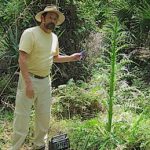
Foraging classes are held rain, shine, hot or cold. Photo by Nermina Krenata
July 15th, Mead Garden: 1500 S. Denning Dr., Winter Park, FL 32789. 9 a.m. meet at the bathrooms.
July 16th, Eagle Park Lake, 1800 Keene Road, Largo, FL 33771. Meet at the pavilion near the dog park. 9 a.m.
For more information, to pre-pay or sign up for a class go here.
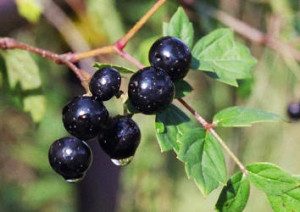
Peppervine got that name for a reason.
Putting on black fruit now is the controversial Pepper Vine, Ampelopsis arborea. It is closely related to the edible grape but also closely related to the toxic Virginia Creeper. It’s one of those plants that some folks say is definitely toxic and others say definitely edible. My personal experience is that it is not edible but I know some credible foragers who say they have eating the ripe berries for a long time with no issue. No doubt the problem has to do with annual calcium oxalate production. In small amounts it’s tolerable. In higher concentrations it can cause skin problems or internally upset digestion. Pepper Vine (so-called because the fruit can give a pepper-like burn) apparently can make little to a lot of the chemical each year, varying greatly. Another possibility is method of preparation. Some people juice the berries and let the juice sit in the refrigerator which allows the acid to precipitates. The juice is then carefully decanted through two coffee filters and used. Not for me but if you do said proceed with caution. The other caution is that Pepper Vine and Wild Grapes can grow intertwined and you can get some Pepper Vine fruit in with your grapes. This also can happen with Virginia Creeper. Pick your grapes carefully.
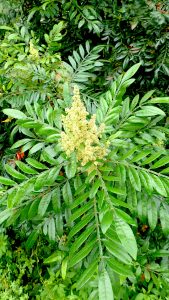
Sumacs are in blossom. Photo by Green Deane
What is that? It’s a common question locally now that Sumacs are in bloom. Their creamy terminal blossoms stand out looking somewhat exotic among the dark green foliage. The most common species here is Winged Sumac which is also one of the most widely-distributed sumac in North America. It’s found nearly everywhere though in different locales other species may dominate. Where I grew up in Maine Staghorn Sumac was the common species and grew quite tall. I see them often when I visit North Carolina. The key to making sure you have an edible sumac and not toxic Poison Sumac or Brazilian Pepper is the location of the blossom and subsequent fruit. Edible sumacs have terminal clusters of medium to dark red berries covered with fine hair. In this case “terminal” means they are on the very end of the branch, like the blossom on the right. Brazilian Pepper has pink berries that are further down the branch. Poison Sumac, which only grows only in wet places, has dull cream to green-cream berries also further down on the stem. To read more about Sumacs go here.

You get the USB, not the key.
150-video USB would be a good end of spring present and is now $99. My nine-DVD set of 135 videos has been phased out. The USB videos are the same videos I have on You Tube. Some people like to have their own copy. The USB videos have to be copied to your computer to play. If you want to order the USB go to the DVD/USB order button on the top right of this page. That will take you to an order form. I’d like to thank all of you who ordered the DVD set over the years which required me to burn over 5,000 DVDs individually.

Green Deane Forum
Want to identify a plant? Perhaps you’re looking for a foraging reference? You might have a UFO, an Unidentified Flowering Object, you want identified. On the Green Deane Forum we — including Green Deane and others from around the world — chat about foraging all year. And it’s not just about warm-weather plants or just North American flora. Many nations share common weeds so there’s a lot to talk. There’s also more than weeds. The reference section has information for foraging around the world. There are also articles on food preservation, and forgotten skills from making bows to fermenting food.
This is weekly newsletter #565. If you want to subscribe to this free newsletter you can find the sign-up form in the menu at the top of the page.
To donate to the Green Deane Newsletter click here.

